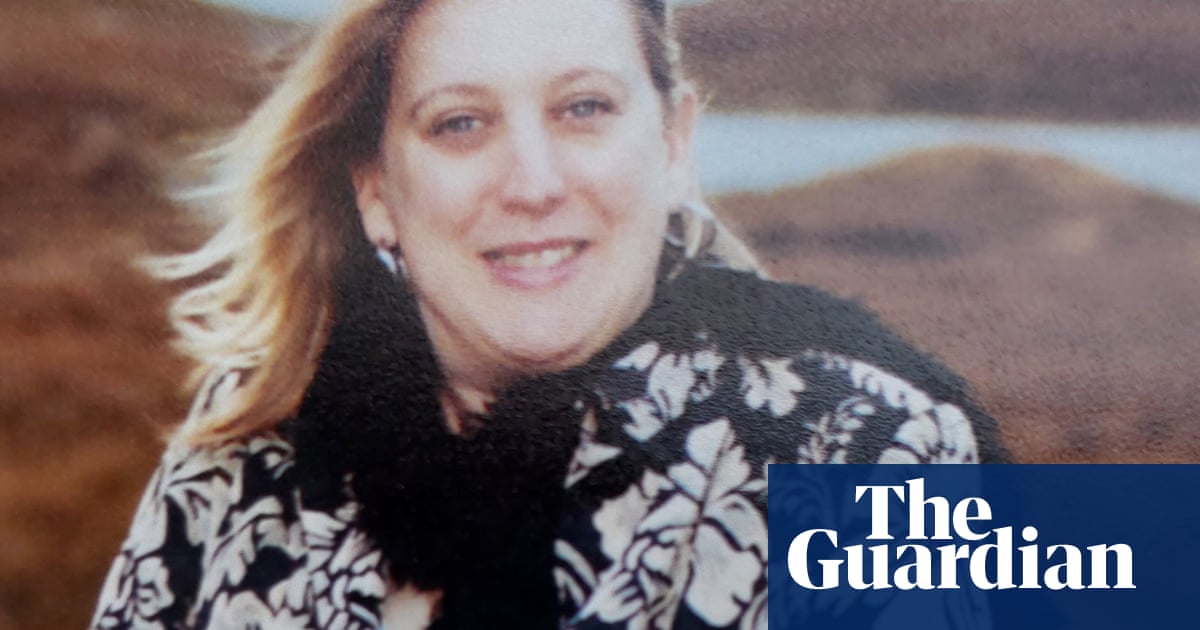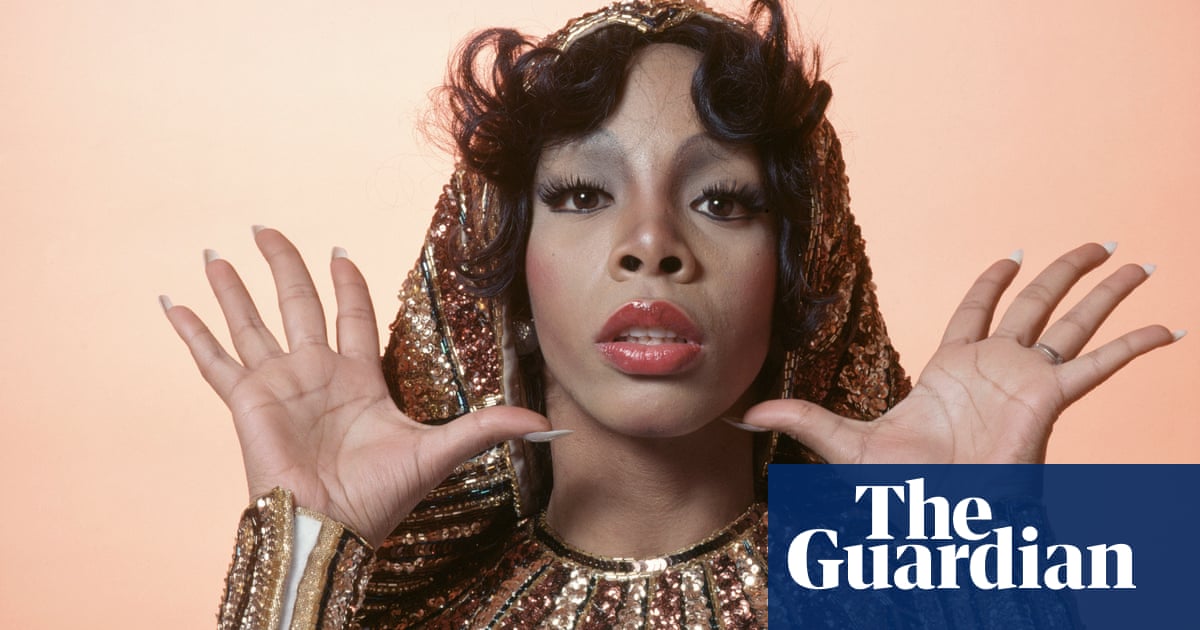
At night, when her daughter was tucked in and her husband had nodded off, Everlyn Nicodemus would make her way to her studio, turn the lights on and begin to paint in the silence. Like a scene from Bong Joon-ho’s Parasite, she would craft nocturnal art in her house in Åkersberga, a suburb of Stockholm, while the world outside slept. By day she was a mother, Swahili teacher and student; by night a clandestine artist.
Forty years on, we’re meeting in the basement of the Richard Saltoun gallery in London’s Mayfair. As Nicodemus makes her way down the stairs, someone asks how she’s doing. “I’m not dead yet,” she deadpans, before sitting down and suddenly springing to life. The truth is she’s not on the wane at all: she’s a live wire, with stories for days and an opinion on everything.
The walls are covered with her paintings: large scale, vivid works that marry religious symbolism and figurative elements and have seen her described as “one of the strongest feminist voices to emerge from Eastern Africa in the past 30 years”. The whole of the upstairs is dedicated to her work too. Nicodemus is not only alive but thriving, having a career renaissance as she approaches 70.
She was born in 1954 in Marangu, the Tanzanian town that is the starting point for most people who scale Mount Kilimanjaro. From an early age, Nicodemus would set off on her own philosophical expeditions which would often put her at odds with authority figures. At church, she questioned the priests about inconsistencies in their teachings – she once threatened to leave the Lutheran church and go to the Catholic one down the road to see if she could get answers. She was so outspoken that her father used to worry about her getting into fights. “He used to tell everybody that he would like to have a big pocket so he could take me everywhere to protect me,” she says. “Because I had no brakes in my mouth. I tell people exactly what I feel.”
Nicodemus puts her pugilistic approach to life down to her grandmother, Makuna, who raised the artist and her siblings in a home with no male authority figure (her parents lived elsewhere in the town). Boys and girls would be treated equally at Makuna’s house. A rota was produced for water collection and everyone was expected to pull their weight. That might seem like a simple egalitarian system but it was radically different to the patriarchal Chagga tradition most children grew up in – and it instilled in Nicodemus a sense of right and wrong, and of what equality looked like. “My grandmother didn’t call herself a feminist,” she says. “For her, it was existential.”
When she went to live with her parents, she would object to being told she had to serve others. “I didn’t fit in. Because here, suddenly, my mother is telling me, ‘Cook breakfast for your brothers.’” To this, she would reply: “Well, I did it yesterday. Tomorrow they’re going to cook breakfast for me.”
Such acts of defiance have become a recurring theme in Nicodemus’s life. As a teenager, she got into teacher training school but then met her first love and eloped with the man who would become her husband: a Swedish economist from a well-to-do family who was working in Tanzania. They got married and after his two-year contract ran out the pair returned to Sweden where they had a daughter, Carolina.
Her relationship with Sweden has soured over the years. She spent 14 years there, mastering the language and bringing up her daughter before she left for France, then Belgium, eventually settling in Scotland in 2008. Before the interview starts, she passes me a note that has a brief, bullet-pointed list with entries including: “I refuse to be a prisoner of racism, sexism and the past … The Swedish chapter of my life is closed.”
Nicodemus arrived in Sweden in 1973, encountering racism for the first time in her life. “That notion was not in my head,” she said. “Even when I married the white man, I didn’t think about the fact he was a different colour. It just didn’t make sense to me. I was equal, just like when I was growing up. There was never this notion of me being inferior. Then suddenly, they’re telling me that I was black, a savage and uncivilised.”
In a bid to understand what was confronting her, Nicodemus decided to study social anthropology. But at university, she was shocked by the euro-centric, reductive attitudes Europeans had towards their subjects, especially Africans. “I didn’t know about ‘othering’. When I came to Sweden, it was the first time I looked at my skin and said, ‘Ah, I’m black.’”
Nicodemus was proud of Marangu: her family were educated; her town had a gallery and a teacher training centre; her father was an artisan, a carpenter who repaired Lutheran churches. The obsession with so-called primitive Africa was anathema to her, so she decided to turn the tables. “I told my professors that I think the people who need to be studied are you anthropologists. I’m going to study you, which means you are going to be my specimen.” What did they say? “They couldn’t believe it.”
Whenever Nicodemus tells one of these stories, it’s accompanied by a laugh that starts as a low, almost inaudible hum and builds into a high-pitched giggle that often leaves her bent double. She’s serious about the prejudice she faced but clearly revels in the mischief she caused, seeing the funny side of the hopeless double standards of those around her.
She decided to move back to Tanzania so Carolina could get to know her family and the Chagga culture. In 1980, Nicodemus first took up painting, after taking part in weekend drawing lessons. After two lessons, she made an announcement: “I said, ‘You know what? Within six months I’m going to exhibit in the Dar es Salaam National Museum.’ Her friends said she was mad but Nicodemus was serious. She began painting and once she had 60 works she approached the director of the Tanzanian museum. “I said, ‘I have come here with my works of art and poems, and I want to be exhibited in this museum. The works are right here, I’m here and I’m not moving until you look at my art.’ He laughed and said, ‘Can we have a cup of tea, first?’”
The director liked her work and gave her an exhibition just as she had predicted. The paintings, and the poetry she created that sat alongside it, came naturally. There wasn’t the racial baggage of anthropology. “I discovered that, when I was doing art, I felt myself,” she says. “This was my identity.”
After getting divorced from her first husband, she met and married the Swedish art historian, TV producer and critic Kristian Romare, who supported her financially so she could focus on her art and poetry full-time. Nicodemus combined her anthropological skills with her artistic practice, using her new freedom to interview women and ask them about their lives: sex workers, cleaners and doctors – no one was excluded or considered unworthy.
The result was Women in the World, which would see Nicodemus travel to Denmark, Tanzania and West Bengal to do interviews and produce paintings inspired by her conversations. “I collected more than 50 hours of tape about what it is to be a woman,” she says. “I started by telling them everything about me, from my childhood to work problems I faced, the racism and sexism. Because of my frankness, they opened up. They talked about incest, rape, abortions, happiness.” More work about trauma followed, such as Silent Strength, a collection of featureless women often in pairs that “addresses the triumph of the human spirit over suffering”; and 2004’s Reference Scroll on Genocide, Massacres and Ethnic Cleansing, a 16-metre-long scroll documenting genocides and ethnic cleansings.
After Romare’s death in 2015, Nicodemus retrained as a care nurse and started work in a home for the elderly in Edinburgh. Some patients had dementia and could be violent. It wasn’t unusual for her to come home with bruises on her arms and wrists after a 12-hour shift. She was struggling to cope and the bills began to add up. Then the gallerist Richard Saltoun approached her, and featured Nicodemus in the 1-52 African Art Fair in 2021 where she was one of the fair’s revelations – despite having had her first solo exhibition in 1980.
“I’m not getting younger,” she says. “So it was just the right time that they discovered me, because I think I couldn’t cope any more.” The interest meant she didn’t have to worry about paying her bills, leaving her to paint whenever she wanted and no longer needing to work at the care home.
It was one of the original paintings created in 1982 in Sweden that would bring Nicodemus her biggest success to date. In March 2022, her work Självporträtt, Åkersberga would become the first painted self-portrait by a black female artist to be acquired by the National Portrait Gallery. “I couldn’t believe it,” she recalls. That moment was the culmination of a journey that started in the foothills of Kilimanjaro. Remarkably, the work was created only two years after she took up painting. A reflection on the various roles she was expected to play – mother, lover, friend, daughter – it’s a rare inward look at an artist who mostly tries to understand others. As well as the solo show at Richard Saltoun and the National Portrait Gallery acquisition, she has also just been offered a scholarship at Princeton.
So does she think all the defiance has finally paid off? “I guess I never learned my place,” she laughs.












